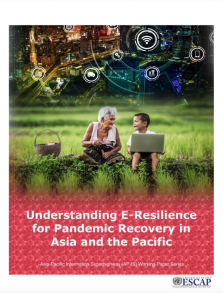
The COVID-19 pandemic has accelerated the digital transformation and underscored its importance for mitigating the economic slowdown, sustaining wellbeing, and speeding up recovery. Governments, smart policymaking, as well as regional cooperation play an essential role in helping to both enable digital transformation to occur and in facilitating access to technology. In this regard, the Secretary-General’s Roadmap for Digital Cooperation, presented on June 11, 2020, comes at a critical inflection point for digital issues by outlining key areas for action to advance a safer, more equitable digital world. The adoption of digital tools contributes substantially to the achievement of the SDGs. The development of the digital infrastructure to reduce the digital divide would first advance SDG 9 (Industry, Innovation, and Infrastructure). By providing access to more health-related information, ICT drives progress on SDG 3 (Good Health and Well-being). Digital tools can also democratize education and facilitate remote working, thereby promoting SDG 4 (Quality Education) and 8 (Decent Work and Economic Growth). Further, ICT can lead to progress on SDG 11 (Sustainable Cities and Communities) and 7 (Affordable and Clean Energy) among other SDGs. Finally, SDG17 identifies technology in general, and ICT specifically, as an essential Means of Implementation for the SDGs and as a tool for supporting international partnership towards the SDGS. Recognizing the importance of digital connectivity and e-resilience for development, as well as for overcoming major challenges such as COVID-19, IDD and TIID of ESCAP presented a number of analytical papers to the Third Session of the Committee on ICT and Science Technology and Innovation (CICTSTI) on August 19-20, 2020. The Committee recommended that the ESCAP secretariat support the expansion of regional collaboration to scale up broadband Internet capacities for technological innovation. In addition, it recognized the importance of collaborative actions to harness technology to address disasters and welcomed collaborative multi-stakeholder efforts to forge technology alliances. The Committee also emphasized the importance of science, technology, and innovation for the achievement of the Sustainable Development Goals in Asia and the Pacific. This paper is aimed to provide a basic overview of the policy responses in support of ICT for development, with a focus on the use of technology in the region under the framework of e-resilience and inclusive broadband, two key pillars of the Asia-Pacific Information Superhighway (AP-IS). This paper is geared towards government officials across Asia and the Pacific that are involved in the formulation and implementation of national policies and programmes affecting ICT, transport, energy infrastructure development, emergency situations, and SDGs in their respective countries. It is also intended for the Working Group on Innovation and Technology for Sustainable Development (ITSD), a subsidiary body under the UN Special Programme for the Economies of Central Asia (SPECA) comprising senior policymakers, researchers, and decision-makers in the areas of digital connectivity, innovation, and technology.


